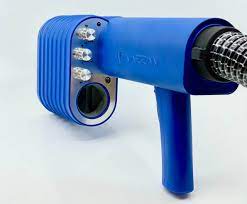Laser rust removal, also known as laser cleaning, is a highly efficient and precise method used to eliminate rust and other unwanted surface contaminants from various materials, including metal, stone, and wood.
This innovative technology relies on the principles of laser physics and material interaction to achieve its goal. In this comprehensive explanation, we will delve into the intricacies of laser rust removal, covering its fundamental principles, equipment, advantages, and Laser Rust Removal Tools.
Principles of Laser Rust Removal
At its core, laser rust removal operates on the principle of selective photothermolysis. This concept involves using laser energy to target and remove specific materials while leaving the surrounding area largely unaffected. The process can be broken down into several key steps:
1. Absorption of Laser Energy: The laser emits a focused beam of light, which carries a high amount of energy. When this laser beam strikes the rusted surface, it is absorbed by the rust particles.
2. Conversion of Energy into Heat: As the rust particles absorb the laser energy, they quickly convert it into heat. This sudden increase in temperature causes the rust to reach its vaporization or sublimation point, depending on the laser settings and material properties.
3. Rust Removal: The vaporized or sublimated rust is expelled from the material’s surface, leaving a clean and rust-free surface behind. This process happens rapidly and precisely, without causing damage to the underlying substrate.
Laser Rust Removal Equipment
The equipment used for laser rust removal consists of several critical components:
1. Laser Source: Various types of lasers can be employed for this purpose, including pulsed fiber lasers, pulsed Nd:YAG lasers, and continuous-wave lasers. The choice of laser depends on the specific application, with factors such as material type, rust thickness, and desired precision influencing the selection.
2. Optics and Scanning System: A set of mirrors and lenses directs and focuses the laser beam onto the rusted surface. A scanning system allows for precise control over the laser’s movement, enabling it to cover the entire affected area systematically.
3. Safety Measures: Laser rust removal generates intense light and heat, which can be harmful to the operator and surroundings. Therefore, safety measures such as protective eyewear and enclosure systems are essential to ensure safe operation.
Advantages of Laser Rust Removal
Laser rust removal offers several significant advantages over traditional rust removal methods like abrasive blasting, chemical treatments, or manual scraping:
1. Precision: Laser cleaning is highly precise, allowing for selective removal of rust without damaging the underlying material. This level of precision is particularly crucial when working on delicate or intricate surfaces.
2. Non-contact: Unlike abrasive methods, laser cleaning is a non-contact process, reducing the risk of surface abrasion or deformation.
3. Environmentally Friendly: Laser cleaning is an eco-friendly method as it doesn’t produce harmful chemicals, dust, or waste. It is a clean and dry process.
4. Minimal Material Loss: Traditional methods often result in some material loss during rust removal. Laser cleaning minimizes this loss, making it suitable for applications where material conservation is critical.
5. Reduced Maintenance: Laser cleaning can extend the lifespan of treated surfaces by preventing further rusting, reducing the need for frequent maintenance.
Applications of Laser Rust Removal
Laser rust removal has a wide range of applications across various industries:
1. Automotive: It is used to prepare surfaces for painting and restoration, removing rust from car bodies and engine components.
2. Aerospace: Laser rust removal is crucial in aerospace applications, where precision and material integrity are paramount.
3. Historical Restoration: This method is invaluable for restoring historical artifacts, monuments, and buildings without causing damage to the original material.
4. Manufacturing: It is used in manufacturing processes to prepare surfaces for welding or bonding.
5. Marine Industry: Ships and offshore structures often undergo laser rust removal to maintain structural integrity and prevent corrosion.
In conclusion, laser rust removal is a cutting-edge technology that offers precision, efficiency, and environmental benefits when compared to traditional rust removal methods. Its wide range of applications across diverse industries highlights its versatility and effectiveness in preserving and restoring various materials. As technology continues to advance, laser rust removal is likely to become even more accessible and indispensable in the field of materials maintenance and restoration.



